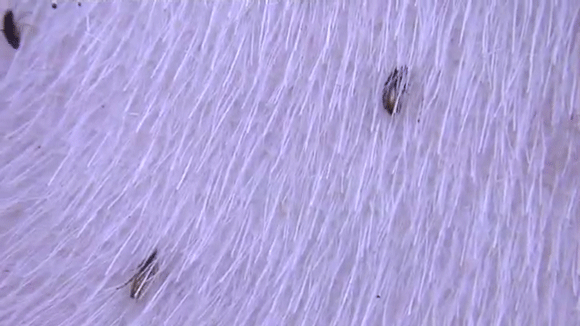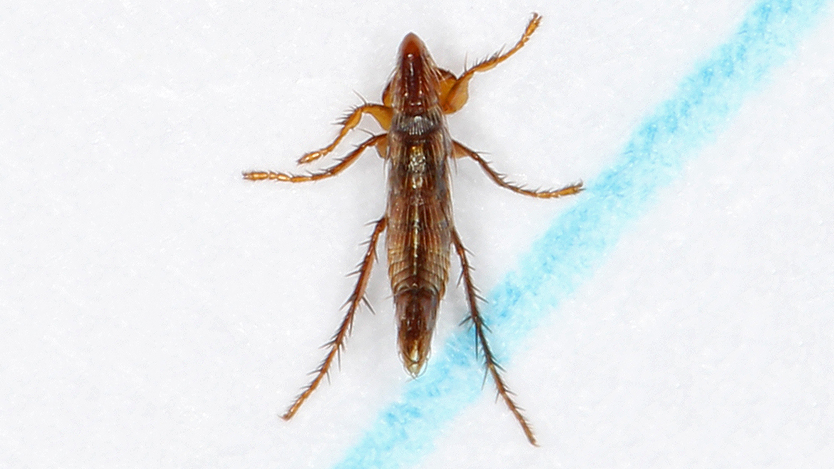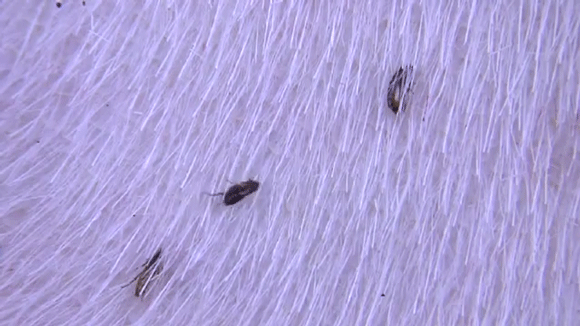
Img 1 Crawling is the primary method of locomotion for adult cat fleas.
Summary
Cat fleas primarily get around by crawling. Jumps are only performed by young adults to acquire hosts. Fleas walk once they’re on a host. Most flea species can also climb.
Details
Different flea species move in different ways. They’ve evolved to successfully exploit their preferred host animal. Cat fleas, for example, are well-adapted for running through dense fur and resisting host grooming.
Walking vs Jumping
Acquiring a Host
Fleas are well-known for their jumping abilities. However, jumps are usually only performed by newly emerged adults to acquire a host. Once emerged from their cocoons, fleas jump from the ground and onto a passing animal. Fleas will also jump if they’re disturbed or are abandoning a dead host.
Fleas Primarily Walk
Fleas, in the adult stage, spend nearly their entire life on a host. Once on an animal, fleas get around exclusively by walking Img 1. As a result, walking is their main type of locomotion.
Walking requires less Energy
Flea jumps require very little energy due to special body mechanisms. They’re jumps are much less taxing than flying is for other insects. Still, jumping is more metabolically demanding than running, as evidenced by increased respiration rates. Air resistance leads to higher energy costs.
Climbing
Getting Closer to Hosts
Most species of fleas can climb. After emerging, they have a natural inclination to climb atop small objects in the environment. This brings them closer to a potential host. Inside homes, fleas will climb to the top of carpet fibers. Outdoors, they’ll ascend blades of grass.
Climbing Walls
Fleas typically don’t climb walls or other structures, but in rare circumstances they may. For instance, they’ve been observed climbing walls in order to escape pesticides being applied to carpets Vid 1.
Vid 1 Video of adult cat fleas climbing walls after insecticide is sprayed on carpets.
Climbing People
Fleas won’t climb up humans. There’s little concern for the insects reaching a person’s hair. Even the pubic area is too far from the ground. Flea jumps reach slightly above a human ankle. Once landing, they bite people right away without much wandering, and leave after feeding.
Physical Adaptations for Moving on Hosts
Laterally Compressed Body
Adult fleas have a laterally compressed body, which appears as if it’s been flattened from side to side Img 2. The flattened body allows fleas to run through host hair with little resistance.

Img 2 The compressed body of fleas allow them to easily move through hair on a host.
Flexible Body
Fleas have thoraxes and abdomens which consist of overlapping segments. These segments can ‘squeeze’ into each other. And, their unique thorax is composed of three separate segments. There’s no pterothorax, a structure typically found in related insects. These adaptations lead to a highly flexible body, allowing fleas to move with agility on a host.
Narrow Head & Protected Antennae
Flea heads are high, narrow, and pointed. As a flea moves forward, its head divides the host’s hairs. On either side of the head, short antennae are recessed into deep grooves (antennal fossae). The grooves protect the antennae from damage as a flea moves through hair.
Combs & Spines
Fleas have thick combs on their head and prothorax. In addition, numerous backwardly-pointed spines and bristles are found on all body parts. The spination doesn’t restrict forward movement, but prevents reverse travel and easy dislodgement. Removal attempts by the host often lead to fleas getting stuck in the haircoat like a cocklebur.
Lubricating Oil
The front of a flea’s body contains numerous pores. These pores are epidermal glands which excrete an oil-like substance onto the cuticle surface. This oily-waxy surface helps fleas to easily glide through host hair. It also gives the fleas a distinctive glossy appearance.





You must log in to post a comment. Log in now.